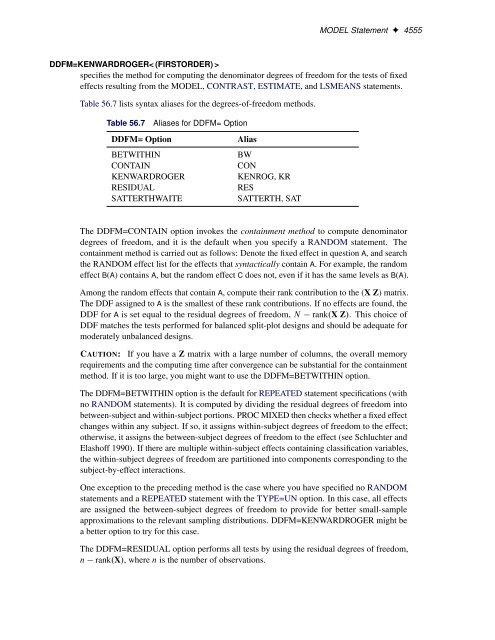SAS/STAT 922 User's Guide: The MIXED Procedure (Book Excerpt)
SAS/STAT 922 User's Guide: The MIXED Procedure (Book Excerpt)
SAS/STAT 922 User's Guide: The MIXED Procedure (Book Excerpt)
Create successful ePaper yourself
Turn your PDF publications into a flip-book with our unique Google optimized e-Paper software.
MODEL Statement ✦ 4555<br />
DDFM=KENWARDROGER< (FIRSTORDER) ><br />
specifies the method for computing the denominator degrees of freedom for the tests of fixed<br />
effects resulting from the MODEL, CONTRAST, ESTIMATE, and LSMEANS statements.<br />
Table 56.7 lists syntax aliases for the degrees-of-freedom methods.<br />
Table 56.7 Aliases for DDFM= Option<br />
DDFM= Option Alias<br />
BETWITHIN BW<br />
CONTAIN CON<br />
KENWARDROGER KENROG, KR<br />
RESIDUAL RES<br />
SATTERTHWAITE SATTERTH, SAT<br />
<strong>The</strong> DDFM=CONTAIN option invokes the containment method to compute denominator<br />
degrees of freedom, and it is the default when you specify a RANDOM statement. <strong>The</strong><br />
containment method is carried out as follows: Denote the fixed effect in question A, and search<br />
the RANDOM effect list for the effects that syntactically contain A. For example, the random<br />
effect B(A) contains A, but the random effect C does not, even if it has the same levels as B(A).<br />
Among the random effects that contain A, compute their rank contribution to the (X Z) matrix.<br />
<strong>The</strong> DDF assigned to A is the smallest of these rank contributions. If no effects are found, the<br />
DDF for A is set equal to the residual degrees of freedom, N rank.X Z/. This choice of<br />
DDF matches the tests performed for balanced split-plot designs and should be adequate for<br />
moderately unbalanced designs.<br />
CAUTION: If you have a Z matrix with a large number of columns, the overall memory<br />
requirements and the computing time after convergence can be substantial for the containment<br />
method. If it is too large, you might want to use the DDFM=BETWITHIN option.<br />
<strong>The</strong> DDFM=BETWITHIN option is the default for REPEATED statement specifications (with<br />
no RANDOM statements). It is computed by dividing the residual degrees of freedom into<br />
between-subject and within-subject portions. PROC <strong>MIXED</strong> then checks whether a fixed effect<br />
changes within any subject. If so, it assigns within-subject degrees of freedom to the effect;<br />
otherwise, it assigns the between-subject degrees of freedom to the effect (see Schluchter and<br />
Elashoff 1990). If there are multiple within-subject effects containing classification variables,<br />
the within-subject degrees of freedom are partitioned into components corresponding to the<br />
subject-by-effect interactions.<br />
One exception to the preceding method is the case where you have specified no RANDOM<br />
statements and a REPEATED statement with the TYPE=UN option. In this case, all effects<br />
are assigned the between-subject degrees of freedom to provide for better small-sample<br />
approximations to the relevant sampling distributions. DDFM=KENWARDROGER might be<br />
a better option to try for this case.<br />
<strong>The</strong> DDFM=RESIDUAL option performs all tests by using the residual degrees of freedom,<br />
n rank.X/, where n is the number of observations.

















